In the realm of medical diagnostics, few technologies have had as profound an impact as X-ray imaging. For decades, X-rays have been a cornerstone of medical imaging, aiding in the identification and diagnosis of a wide range of conditions. However, the traditional film-based X-ray systems have given way to a new era of innovation with the advent of digital X-ray technology. In recent years, significant advancements in digital X-ray technology have reshaped the landscape of medical imaging, offering unprecedented image quality, enhanced efficiency, and improved patient care.
The Transition from Analog to Digital
Digital X-ray technology marks a paradigm shift from the conventional analog film-based X-ray systems. Traditional X-ray imaging involved exposing a patient to ionizing radiation, with the resulting image captured on film. This process had limitations in terms of image quality, accessibility, and storage. Enter digital X-ray technology, which employs digital detectors to capture X-ray images directly and then convert them into electronic signals.
Advantages of Digital X-ray Technology
Enhanced Image Quality:
Digital X-ray systems offer significantly higher image quality compared to traditional methods. The ability to adjust contrast, brightness, and other parameters digitally ensures that subtle details are not lost in the imaging process. This leads to more accurate diagnoses and better patient outcomes.
Lower Radiation Dose:
Advanced digital X-ray systems often require lower radiation doses compared to their analog counterparts. This is achieved through dose optimization algorithms and improved detector sensitivity, reducing the potential risks associated with radiation exposure for both patients and healthcare providers.

Immediate Image Availability:
One of the most significant advantages of digital X-ray technology is the instant availability of images. Unlike traditional methods that required film development, digital images can be viewed on a computer screen within seconds of exposure. This rapid turnaround time is crucial in emergency situations and for making quick medical decisions.
Storage and Accessibility:
Digital images are easily stored and can be archived electronically, eliminating the need for physical storage space required for film-based X-rays. This accessibility also enables remote viewing and sharing of images, allowing healthcare professionals to collaborate seamlessly and consult with experts across the globe.
Post-processing Capabilities:
Digital X-ray images can be manipulated and enhanced using various software tools, allowing for better visualization of specific areas of interest. This aids radiologists in identifying anomalies that might otherwise be overlooked.
Integration with Health Records:
Modern digital X-ray systems can integrate seamlessly with electronic health records (EHR) systems. This integration streamlines the documentation process and ensures that imaging results are readily available to authorized medical personnel.
Versatility:
Digital X-ray technology is not limited to traditional X-ray machines. It has also paved the way for innovations such as computed tomography (CT) scanners, fluoroscopy, and portable X-ray devices, expanding its applications across various medical specialties.
Future Directions
The evolution of digital X-ray technology is far from over. As research and development continue, we can expect even more remarkable advancements, including:
- 3D Imaging: Three-dimensional digital X-ray imaging could provide more comprehensive insights into complex anatomical structures, aiding in surgical planning and enhancing precision.
- Artificial Intelligence (AI) Integration: AI algorithms are being developed to assist radiologists in identifying patterns and anomalies in X-ray images more accurately and efficiently. This could lead to quicker diagnoses and reduced human error.
- Dose Reduction Techniques: Ongoing efforts to further minimize radiation exposure through advanced dose reduction techniques will make X-ray imaging even safer for patients.
- Point-of-Care and Remote Imaging: Portable digital X-ray devices could become more compact and accessible, enabling point-of-care imaging in remote locations or during emergencies.
In Conclusion
The advancements in digital X-ray technology have revolutionized medical imaging by providing improved image quality, lower radiation exposure, instant availability of results, and enhanced collaboration among healthcare professionals. The transition from traditional film-based X-rays to digital systems signifies a significant leap forward in patient care and diagnostic accuracy. As technology continues to evolve, we can anticipate even more exciting developments that will further elevate the capabilities of digital X-ray imaging, ultimately leading to better healthcare outcomes for patients around the world.






